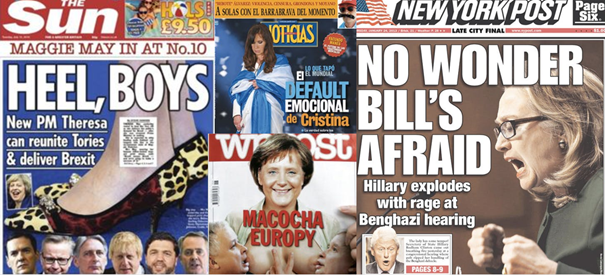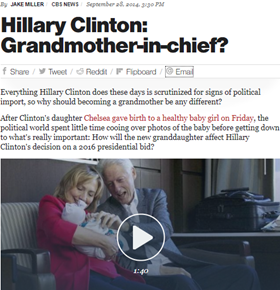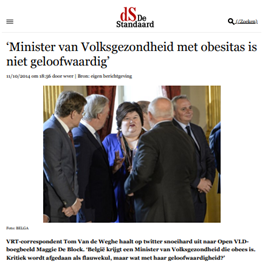Eerlijke verkiezingen? Vrouwelijke politieke kandidaten geconfronteerd met stereotyperende krantenberichtgeving

Onderzoek naar de representatie van vrouwelijke politieke kandidaten staat sterk in de Verenigde Staten. Telkens toont het aan dat vrouwelijke verkiezingskandidaten onderhevig zijn aan nieuwsberichtgeving die genderstereotypen in stand houdt. Maar wat is de stand van zaken in Vlaanderen? Niet veel beter, zo blijkt. Zowel naar aanloop van de federale verkiezingen (2007, 2014) als de lokale verkiezingen (2012, 2018) werden vrouwelijke kandidaten op een nadelige wijze gerepresenteerd in kranten.
Wanneer we stemmen, houden we al dan niet bewust rekening met wat we in de media gehoord, gelezen en gezien hebben. We gaan uit van een zekere objectiviteit en creëren op basis van nieuwsberichten een beeld van politici en partijen. Maar hier knelt het schoentje al voor vrouwelijke kandidaten. Niet alleen wordt er in kranten minder berichtgegeven over vrouwelijke dan over mannelijke kandidaten, ook inhoudelijk ondervinden vrouwelijke kandidaten een nadeel.
Eerdere, voornamelijk Amerikaanse studies toonden aan dat er bij vrouwelijke kandidaten vaker gerapporteerd wordt over de leeftijd, het uiterlijk, de maritale status en de ouderlijke rol. In vergelijking met mannelijke kandidaten wordt het geslacht van vrouwelijke kandidaten sterker benadrukt, is de berichtgeving negatiever en worden politieke kwesties minder vaak aangehaald.

Ondanks genderquota, ook in Vlaanderen
De voorbeelden van stereotyperingen in Amerikaans onderzoek zijn opvallend. Democratisch presidentskandidaat Hillary Clinton ontving in de Verenigde Staten een hoop aandacht voor haar mantelpakken. Er werd gedurende de campagne van Sarah Palin in 2008 door een krant naar haar verwezen als ‘Barbie’. Voorbeelden dichter bij huis, in onze eigen media, zijn moeilijker op te noemen. De laatste keer dat een prominente Vlaamse politicus de ongelijkheid tussen vrouwelijke en mannelijke politici aankaartte was door Maggie De Block in 2014. Toen zij benoemd werd tot federaal minister van Volksgezondheid kwam er kritiek op deze keuze wegens haar overgewicht. Hoewel de kritiek haar oorsprong niet kende in de traditionele media, berichtten deze er wel over.

Onderzoek toont nu aan dat Vlaamse vrouwelijke politici wel degelijk een nadeel ondervinden in de krantenberichtgeving over hun kandidaturen. 390 nieuwsstukken over nieuw aangekondigde kandidaturen uit 4 kranten werden onderzocht: De Morgen, Het Laatste Nieuws, Het Nieuwsblad en De Standaard. Zowel het regionaal als het nationaal nieuws van deze kranten werden in het onderzoek opgenomen naar aanloop van 2 federale (2007, 2014) en 2 lokale verkiezingen (2012, 2018).
Uit de analyse van de nieuwsstukken blijkt dat er bijna dubbel zoveel gerapporteerd werd over mannelijke (65,4%) dan over vrouwelijke kandidaten (34,6%). Dit is opvallend, aangezien de lijstopstelling in België onderhevig is aan genderquota waardoor vrouwen en mannen in gelijke mate op de kieslijsten vertegenwoordigd moeten zijn. Een deel van de verklaring vindt het onderzoek in de grotere aanwezigheid van mannelijke politici bij meer belangrijke kandidaturen, zoals lijsttrekker en -duwer. Deze kandidaturen kunnen gewoonlijk van meer persaandacht genieten. Het verklaart ook deels het verschil in artikellengte, zo waren de artikels over vrouwelijke kandidaten over het algemeen korter in lengte dan de artikels over mannelijke kandidaten.
Op inhoudelijk vlak legt het onderzoek enkele vormen van stereotyperende berichtgeving bloot. De maritale status van vrouwelijke politici werd vaker vermeld, net als hun ouderlijke rol. Terwijl er in 14,1% van alle artikels over vrouwelijke kandidaten naar hun kinderen werd verwezen, was dit slechts het geval bij 3,5% van de artikels over mannelijke kandidaten. Ook werd in meer dan de helft van de artikels over vrouwelijke kandidaten hun leeftijd vermeld. Dit gebeurde duidelijk minder vaak bij mannelijke kandidaten (38,8% van de gevallen). Bovendien werd de leeftijd van vrouwelijke politici het vaakst aangehaald bij de jongste leeftijdscategorieën. En hoewel het verschil in het onderzoek niet opvallend was, werd er bij mannelijke kandidaten vaker vermelding gemaakt van politieke info (69% t.o.v. 63% bij vrouwen) en bij vrouwelijke kandidaten van persoonlijke info (47,4% t.o.v. 45,5% bij mannen).
Niet onschuldig
Dergelijke representaties kunnen onschuldig lijken, maar dat zijn ze allesbehalve. Wanneer kiezers al volgens bepaalde genderstereotypen denken, ondersteunen stereotiep vrouwelijke representaties in het nieuws deze denkbeelden. Dit kan vervolgens leiden tot minder stemmen. Door de maritale status en moederrol van vrouwelijke politici te benadrukken, worden vrouwelijke politici namelijk binnen de private of huiselijke sfeer geplaatst. Dit kan het oude idee met zich meebrengen dat vrouwen niet in de publieke of politieke sfeer zouden thuishoren.
Ook de kleinere numerieke representatie van vrouwelijke politici blijft niet zonder gevolgen. Eerder onderzoek heeft aangetoond dat hoe vaker een bepaalde politicus in het nieuws komt, hoe groter de mogelijkheid van kiezers is om hem/haar te herkennen. Een grotere herkenning van een politicus wordt gelinkt met een groter aantal stemmen. Aangezien dit onderzoek aantoonde dat mannelijke kandidaten bijna dubbel zo vaak gerepresenteerd worden, wordt een pessimistisch beeld geschetst. Kleine lichtpunten zijn dat er zowel binnen de federale als lokale verkiezingen een stijging op te merken is in het percentage artikels over vrouwelijke kandidaten. Zo steeg het percentage bij de federale van 32,6% in 2007 naar 41,1% in 2014, en bij de lokale verkiezingen van 26% in 2012 naar 39% in 2018. Pessimistischer is dat de inhoudelijk stereotiepe representaties zich in elk verkiezingsjaar duidelijk bleven manifesteren.
Daarom is er nood aan meer bewustwording bij journalisten en nieuwsorganisaties. Wanneer beperkte en stereotiepe krantenberichtgeving over vrouwelijke politici zorgt voor minder stemmen, heeft het een invloed op hoe de regering eruitziet. Het hebben van minder vrouwelijke politici in een regering heeft dan weer een invloed op wat voor beleid gevoerd wordt. Hoewel de sprongen groot kunnen lijken, is de invloed van nieuwsmedia op kiezers reëel. Vandaag heerst onder journalisten het bewustzijn al dat politieke partijen naar aanloop van de verkiezingen in een gelijke mate vertegenwoordigd moeten worden. Nu nog hetzelfde voor vrouwelijke politici.
Bibliografie
Aday, S. & Devitt, J. (2001). Style over substance: newspaper coverage of Elizabeth Dole’s presidential bid. The Harvard International Journal of Press/Politics, 6(2), 52-73.
Adcock, C. (2010). The politician, the wife, the citizen, and her newspaper. Feminist Media Studies, 10(2), 135-159.
Atkeson, L.R. (2003). Not all cues are created equal: the conditional impact of female candidates on political engagement. Journal of Politics, 65(4), 1040-1061.
Atkeson, L.R. & Krebs, T.B. (2008). Press coverage of mayoral candidates: the role of gender in news reporting and campaign issue. Political Research Quarterly, 61(2), 239-52.
Baird, J. (2004). Media tarts: how the Australian press frames female politicians. Melbourne: Scribe Publications.
Banwart, M.C. (2010). Gender and candidate communication: effects of stereotypes in the 2008 election. American Behavioral Scientist, 54(3), 265-283.
Banwart, M.C., Bystrom, D.G. & Robertson, T.A. (2003). From the primary to the general election: a comparative analysis of candidate media coverage in mixed-gender 2000 races for governor and U.S. Senate. American Behavioral Scientist, 46(5), 658-676.
Bernstein, A. (2002). Is it time for a victory lap? Changes in the media coverage of women in sport. International Review for the Sociology of Sport, 37(4), 415-428.
Braden, M. (1996). Women, politicians and the media. Lexington: University of Kentucky Press.
Bystrom, D. (1999, november). Why Not a woman? Reactions to the presidential candidacy of Elizabeth Dole. Paper gepresenteerd voor de National Communication Association convention, Chicago.
Bystrom, D. (2006). Advertising, web sites, and media coverage: gender and communication along the campaign trail. In S.J. Carroll & R.L. Fox (Eds.), Gender and elections: shaping the future of American politics (pp. 169-188). Cambridge: Cambridge University Press.
Bystrom, D.G., Banwart, M.C., Kaid, L.L. & Robertson, T.A. (2004). Gender and candidate communication: VideoStyle, WebStyle, NewsStyle. New York: Routledge.
Bystrom, D.G., Robertson, T.A. & Banwart, M.C. (2001). Framing the fight: an analysis of media coverage of female and male candidates in primary races for governor and U.S. Senate in 2000. American Behavioral Scientist, 44(12), 1999-2013.
Campbell, D.E. & Wolbrecht, C. (2006). See Jane run: women politicians as role models for adolescents. The Journal of Politics, 68(2), 233-247.
Carlin, D.B. & Winfrey, K.L. (2009). Have you come a long way, baby? Hillary Clinton, Sarah Palin, and sexism in 2008 campaign coverage. Communication Studies, 60(4), 326-343.
Couldry, N. (2000). The place of media power: pilgrims and witnesses of the media age. Londen: Routledge.
Curnalia, R.M.L. & Mermer, D.L. (2014). The “Ice Queen” melted and it won her the primary: evidence of gender stereotypes and the double bind in news frames of Hillary Clinton's “emotional moment”. Qualitative Research Reports in Communication, 15(1), 26-32.
Davis, J. (1982). Sexist bias in eight newspapers. Journalism Quarterly, 59(3), 456-460.
De Standaard (2014, 11 oktober). ‘Minister van Volksgezondheid met obesitas is niet geloofwaardig’. Geraadpleegd op 18 februari 2017 op het World Wide Web: http://www.standaard.be/cnt/dmf20141011_01315880
Devitt, J. (1999). Framing gender on the campaign trail: women's executive leadership and the press. Washington, DC: The Women's Leadership Fund.
Devitt, J. (2002). Framing gender on the campaign trail: female gubernatorial candidates and the press. Journalism and Mass Communication Quarterly, 79(1), 445-463.
De Vuyst, S., Vertoont, S. & Van Bauwel, S. (2015). Global media monitoring project 2015: national report Belgium (Flanders). Geraadpleegd op 11 maart 2017 op het World Wide Web: http://cdn.agilitycms.com/who-makes-the-news/Imported/reports_2015/nati…
Dimitrova, D.V. & Geske, E. (2009, mei). To cry or not to cry: media framing of Hillary Clinton in the wake of the New Hampshire primary. Paper gepresenteerd voor de jaarlijkse samenkomst van de International Communication Association, Chicago.
Fox, R.L. (1997). Gender dynamics in congressional elections. Thousand Oaks, C.A.: Sage Publications.
Gallagher, M. (2001). Gender setting: new agendas for media monitoring and advocacy. Londen: Zed Books.
Garcia-Blanco, I. & Wahl-Jorgensen, K. (2012). The discursive construction of women politicians in the European press. Feminist Media Studies, 12(3), 422-441.
George, C., Hartley, A. & Paris, J. (2001). The representation of female athletes in textual and visual media. Corporate Communications: An International Journal, 6(2), 94-101.
Gidengil, E. & Everitt, J. (2000). Filtering the female: television news coverage of the 1993 Canadian leaders’ debates. Women and Politics, 21(4), 105-31.
Gidengil, E. & Everitt, J. (2003). Talking tough: gender and reported speech in campaign news coverage. Political Communication, 20, 203-232.
GMMP (Global Media Monitoring Project) (1995). Who makes the news? Global Media Monitoring Project 1995. Londen: World Association for Christian Communication.
GMMP (Global Media Monitoring Project) (2000). Who makes the news? Global Media Monitoring Project 2000. Londen: World Association for Christian Communication.
GMMP (Global Media Monitoring Project) (2005). Who makes the news? Global Media Monitoring Project 2005. Londen: World Association for Christian Communication.
GMMP (Global Media Monitoring Project) (2010). Who makes the news? Global Media Monitoring Project 2010. Londen: World Association for Christian Communication.
GMMP (Global Media Monitoring Project) (2015). Who makes the news? Global Media Monitoring Project 2015. Londen: World Association for Christian Communication.
Goldenberg, E.N. & Traugott, M.W. (1987). Mass media effects in recognizing and rating candidates in U.S. senate elections. In J. Vermeer (Ed.), Campaigns in the news: mass media and congressional elections. New York: Greenwood Press.
Grandy, K. (2010). Busy bee, tough mom, farmer's daughter: the Canadian business press portrayal of Annette Verschuren. Canadian Journal of Communication, 35(1), 49-62.
Hallin, D.C. & Mancini, P. (2004). Comparing media systems: three models of media and politics. Cambridge: Cambridge University Press.
Hansen, A. (2009). Mass communication research methods. Thousand Oaks, C.A.: SAGE Publications.
Hansen, S.B. (1997). Talking about politics: gender and contextual effects on political proselytizing. Journal of Politics, 59(1), 73-103.
Heldman, C., Carroll, S.J. & Olson, S. (2000, augustus). Gender differences in print media coverage of presidential candidates: Elizabeth Dole’s bid for the Republican nomination. Paper gepresenteerd voor de American Political Science Association annual meeting, Washington D.C.
Heldman, C., Carroll, S.J. & Olson, S. (2005). “She brought only a skirt”: print media coverage of Elizabeth Dole’s bid for the Republican presidential nomination. Political Communication, 22(3), 313-335.
Hooghe, M., Jacobs, L. & Claes, E. (2015). Enduring gender bias in reporting on political elite positions: media coverage of female MPs in Belgian news broadcasts (2003-2011). The International Journal of Press/Politics, 20(4), 395-414.
Huddy, L. & Terkildsen, N. (1993). Gender stereotypes and the perception of male and female candidates. American Journal of Political Science, 37(1), 119-147.
Humprecht, E. & Esser, F. (2017). A glass ceiling in the online age? Explaining the underrepresentation of women in online political news. European Journal of Communication, 32(5), 439-456.
Jacobson, G.C. (1987). The politics of congressional elections. Boston: Little, Brown.
Jamieson, K.H. (1995). Beyond the double bind: women and leadership. New York: Oxford University Press.
Kahn, K.F. (1992). Does being male help? An investigation of the effects of candidate gender and campaign coverage on evaluations of U.S. Senate candidates. The Journal of Politics, 54(2), 497-517.
Kahn, K.F. (1994a). The distorted mirror: press coverage of women candidates for statewide office. The Journal of Politics, 56(1), 154-173.
Kahn, K.F. (1994b). Does gender make a difference? An experimental examination of sex stereotypes and press patterns in statewide campaigns. American Journal of Political Science, 38(1), 162-195.
Kahn, K.F. & Goldenberg, E.N. (1991) Women candidates in the news: an examination of gender differences in U.S. Senate campaign coverage. Public Opinion Quarteley, 55(2), 180-199.
Koch, J. (1997). Candidate gender and women’s psychological engagement in politics. American Politics Quarterly, 25(1), 118-133.
Krippendorff, K. (2004). Content analysis: an introduction to its methodology (2nd ed.). Thousand Oaks, C.A.: Sage.
Lavie, A. & Lehman-Wilzig, S. (2003). Whose news? Does gender determine the editorial product? European Journal of Communication, 18(1), 5-29.
Len-Ríos, M.E., Rodgers, S., Thorson, E. & Yoon, D. (2005). Representation of women in news and photos: comparing content to perceptions. Journal of Communication, 55(1), 152-168.
Lühiste, M. & Banducci, S. (2016). Invisible women? Comparing candidates’ news coverage in Europe. Politics & Gender, 12(2), 223-253.
Meeks, L. (2012). Is she 'man enough'? Women candidates, executive political offices, and news coverage. Journal of Communication, 62(1), 175-193.
Meier, P. (2012). From laggard to leader: explaining the Belgian gender quotas and parity clause. West European Politics, 53(2), 362-79.
Mendes, K. & Carter, C. (2008). Feminist and gender media studies: a critical overview. Sociology Compass, 2(6), 1701-1718.
Muir, K. (2005). Political cares: gendered reporting of work and family issues in relation to Australian politicians. Australian Feminist Studies, 20(46), 77-90.
Nilsen, A.P. (1977). Sexism as shown through the English vocabulary. In A.P. Nilsen, H. Bosmagian, H.L. Gershuny & J.P. Stanley (Eds.), Sexism and language (pp. 27-42). Urbana, IL: National Council of Teachers of English.
Norris, P. (1997). Women, media and politics. New York: Oxford University Press.
Poutanen, S., Kovalainen, A. & Jännäri, J. (2016). Construction of the female global top manager in The Economist. International Journal of Media & Cultural Politics, 12(2), 193-212.
Robertson, T., Conley, A., Scymcznska, K. & Thompson, A. (2002). Gender and the media: an investigation of gender, media, and politics in the 2000 election. New Jersey Journal of Communication, 10(1), 104-117.
Rodgers, S. & Thorson, E. (2003). A socialization perspective on male and female reporting. Journal of Communication, 53(4), 658–675.
Rodgers, S., Thorson, E. & Antecol, M. (2001). “Reality” in the St. Louis Post-Dispatch. Newspaper Research Journal, 21(3), 51–68.
Ross, K. & Comrie M. (2012). The rules of the (leadership) game: gender, politics and news. Journalism Studies, 13(8), 969-984.
Ross, K., Evans, E., Harrison, L., Shears, M. & Wadia, K. (2013). The gender of news and news of gender: a study of sex, politics, and press coverage of the 2010 British General Election. The International Journal of Press/ Politics, 18(1), 3-20.
Schneider, M.C. & Bos, A.L. (2013). Measuring stereotypes of female politicians. Political Psychology, 35(2), 245-266.
Shor, E., van de Rijt, A., Ward, C., Blank-Gomel, A. & Skiena, S. (2014). Time trends in printed news coverage of female subjects, 1880-2008. Journalism Studies, 15(6), 759-773.
Smith, K.B. (1997). When all’s fair: signs of parity in media coverage of female candidates. Political Communication, 14(1), 71-82.
Sreberny, A. & van Zoonen, L. (Eds.) (2000). Gender, politics and communication. Cresskill, N.J.: Hampton Press.
Storey, J. (2015). Cultural theory and popular culture: an introduction (7e ed.). Londen & New York: Routledge.
Sutton, L.A. (1995). Bitches and skanky hobags. In K. Hall & M. Bucholtz (Eds.), Gender articulated: Language and the socially constructed self (pp. 279-296). New York: Routledge.
Tuchman, G. (1979). Women’s depiction by the mass media. Signs, 4(3), 528-542.
Turk, J.V. (1987). Sex-role stereotyping in writing the news. Journalism Quarterly, 64(2/3), 613- 617.
van Zoonen, L. (1988). ‘Rethinking women and the news. European Journal of Communication, 3(1), 35-53.
van Zoonen, L. (1998a). “Finally, I have my mother back”. Politicians and their families in popular culture. The International Journal of Press/Politics, 3(1), 48-64.
van Zoonen, L. (1998b). One of the girls? The changing gender of journalism. In C. Carter, G. Branston & S. Allen (Eds.), News, gender and power (pp. 33-46). Londen: Routledge.
Vos, D. (2013). The vertical glass ceiling: explaining female politicians’ underrepresentation in television news. Communications, 38(4), 389-410.
Vu, H.T., Duong, H.T., Barnett, B. & Lee, T.T. (2017). A role (in)congruity study on Vietnamese journalists’ perception of female and male leadership. Asian Journal of Communication, 27(6), 648-664.
Wahl-Jorgensen, K. & Ye, W. (2015). Gender and politics. In K. Barnhurst (Ed.), The International Encyclopedia of Political Communication. Londen/New York: Palgrave MacMillan.
Walsh, C. (2001). Gender and discourse: language and power in politics, the church and organisations. Pearson Education: Harlow.
Wasburn, P.C. & Wasburn, M.H. (2011). Media coverage of women in politics: the curious case of Sarah Palin. Media, Culture & Society, 33(7), 1027-1041.
Zoch, L.M. & Turk, J.V. (1998). Women making news: gender as a variable in source selection and use. Journalism & Mass Communication Quarterly, 75(4), 762-775.












